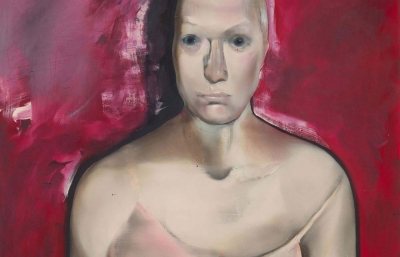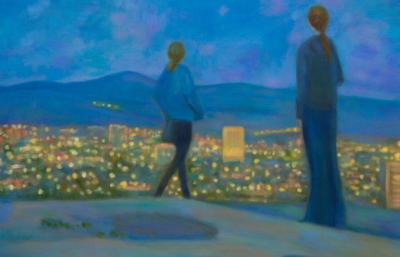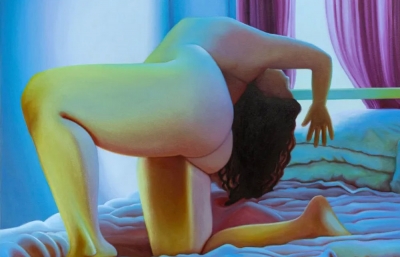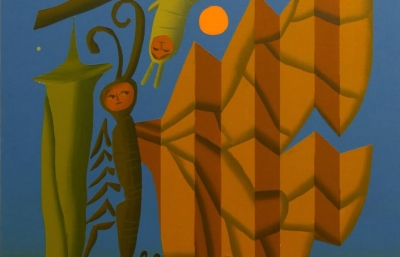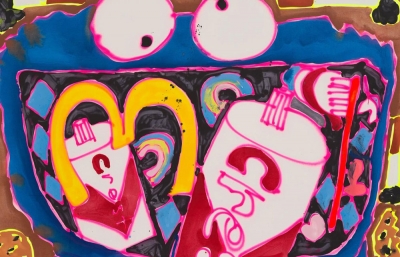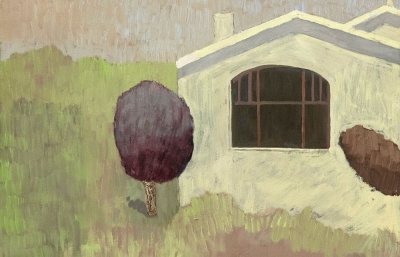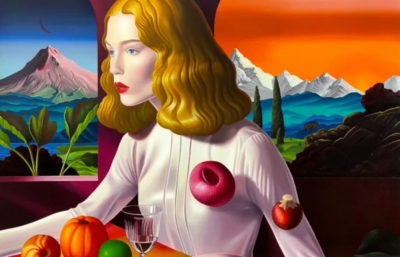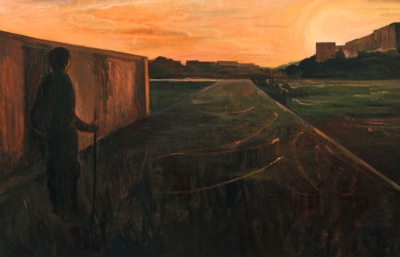There is a duality in Dutch painter Martine Johanna’s artwork that reveals itself between, as the artist puts it, “the visible and nonvisible world.” Warm, vibrant colors pull you in, while cooler ones push you away. Entranced eyes gaze outward, away from the viewer, but invite you to peer inside at a complex assortment of thoughts and emotions, exposing what feels like everything and nothing all at once. As she prepares for her first solo show in the US, "Dancer," at Spoke Art in San Francisco, Johanna chats with us about feeling as opposed to seeing, momentum, collective memories, and learning the value of the present.
Read this interview and more in the November 2016 issue of Juxtapoz Magazine.
Alex Nicholson: What was your earliest creative endeavor?
Martine Johanna: I’ve been drawing since I could hold a pencil. But one particular memory that also helped me develop my own opinions is drawing a unicorn with wings in bible class when I was ten years old. The headmaster, who was also a preacher, took it from me and mounted it on the wall, stating the drawing was blasphemous because God didn't create unicorns. It didn't shake me. I was proud that I had my first exhibition and knew then that one day, I would make it my profession.
I'm drawn to the facial expressions in your paintings. What are your subjects thinking? What are they looking at?
What drives me to make the choice for these expressions is to somehow communicate internal psychic landscapes or movements in them, which you cannot actually see; you just feel their presence. I’m endlessly fascinated by that internal world, the complexity of thought processes, drive and decision making, the visible and nonvisible world. It might also be a reference of strength and escapism. There are no disconnects present.

Photo: Louis Reith
What inspires your bright color palette?
My greatest memories as a kid are filled with colors, like flashbacks into a perfect world. While working, I get obsessed by its opposing effects, how cold colors bring distance and warm colors, closeness. It also affects intuitive associations from our collective memory and instincts. With color, you affect moods and strengthen that which you are trying to convert.
In addition to your colorful childhood memories, is any other part of your paintings autobiographical?
I think all artist’s work is, in some sense, autobiographical. There is always something mirroring from the inside out—just as I am a female, a dreamer, hypersensitive, introverted outwards and extroverted inwards.
What are you exploring in these new paintings for Spoke Art?
I have titled the exhibition Dancer because, as life takes its course, regular things happen, good things happen and the bad is never far away. I am going through some trying times now and after my last solo in Amsterdam, I felt quite overwhelmed. When I was thinking about a concept, I found a solution in the abstraction of movement, like looking for magic in the static and flight in the motion. Dance is one of the oldest forms of communication and storytelling. It consists of purposefully or instinctively selected sequences of motion and conveys or processes emotions without using words. It is a way of storytelling, a social healing ritual, sacred, ceremonial, and it can lead to ecstatic trance states. And the wonderful thing is it has momentum.

Photo: Louis Reith
What has your experience been like in navigating the art world? Has it been difficult?
Sometimes, yes. I mean, I keep working no matter what. I am my own toughest critic, and my aims are always just out of reach. But there are a lot of strange politics in the art world. It is often contradictory to what art should have: freedom. Once art is established, it is not that interesting anymore because something that is established can, in itself, not renew, and it is hard for newcomers to breach the code of conduct. I read Bourdieu’s Distinction, and the art world feels like that—judgments of taste are related to social positions, and those positions and structures that hold them together are mostly also established and hard to become part of. Especially, like many artists, when your talent is making and not necessarily socializing. Fortunately, there are shifts happening that allow room for emerging artists to get more exposure. Because art is a reflection of society, and society has easier access to all levels of art, it is something that the established art world cannot ignore. Because of this, there are many new curators and galleries holding successful pop-up shows and exhibits. Museum exhibitions are becoming more daring and interactive as well. All this makes way for new generations of artists to come. It’s all very exciting.
Do you see your work as relating to any current cultural or art movement?
Maybe in the revival of figurative art. Some people say my work is hyperreal, but that is absolutely not the case. It’s also not Surrealism or Pop art. I don’t know, I rather not be put in a movement, because that leaves so little room for experimentation.
Are there particular books or movies that you continue to revisit?
I used to revisit Jodorowsky, Dario Argento, and films like Under the Skin, Only Lovers Left Alive, or Hausu. But somehow, over the years, I’ve become a bits-and-pieces information freak, reading everything about anything that I’m drawn to, from Modernist architecture to the history of female mental illness. While I paint, I usually binge-watch or listen to documentaries about all kinds of subjects, most of them on human nature. I do have to watch out that it doesn't negatively affect my mood, though. I spend so many hours in the studio that I can feel estranged from the outside world. So much so that a trip to the supermarket can seem like climbing Mount Everest. Sometimes I listen to music, which is actually far healthier.

Photo: Louis Reith
If you could have a conversation with any artist, dead or living, which would it be?
Helen Frankenthaler. She was an abstract expressionist painter known for her color field paintings. Despite the era she was active in, the ’50s and ’60s, as a female and recognized painter, she did not shy away from making her own statements, whether in size, form or boldness. She did not conform to any set image of the female artist. She was eager to learn and looked for her own truth and expression, counteracting any existing stereotype. She would still be considered a rarity today. I would love to ask her where she drew her fearlessness from since the odds were against her.
What's the best piece of advice about life or art you've been given?
It was from my dad who told me, “Everything will always be okay again.” He died suddenly in 2001. His last words in the ambulance before slipping into a coma were, “Is this really necessary?” I was devastated but have found, through the years, that it is true: if you are aware of the here and now, there are always things to appreciate, even in the hardest times. He was a man that always knew how to draw the sting out of any heartache with his soothing smile and calm, reassuring demeanor. He was obsessed with his work as a technical inventor, which was very inspiring to me. Although I’m a dreamer at heart, I can treat most things very matter-of-factly and feel at ease with them... most of the time.
----
Originally published in the November 2016 issue of Juxtapoz Magazine, on newsstands worldwide and in our web store.







